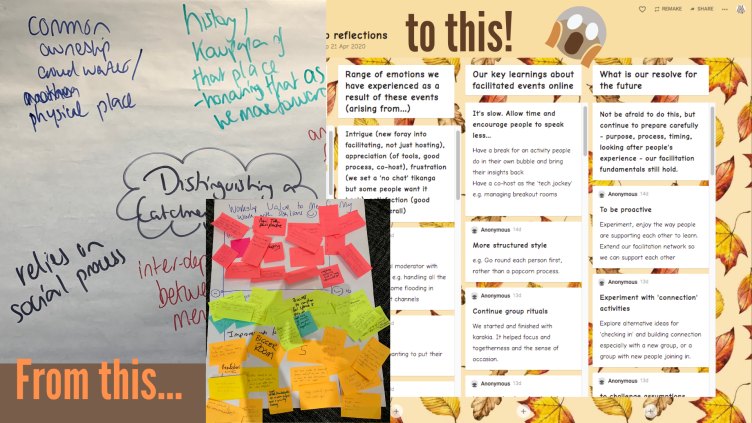It’s the first week of our (slightly more relaxed!) Level 3 covid-19 lockdown here in NZ. And whilst quite a few people are back at work, physical distancing and remote working / learning – and therefore virtual meetings – continues as Business As Usual for everyone else.
Recently, our two practice groups combined for the first time, meeting virtually by Zoom as a ToP Facilitators’ Community of Practice. We shared some successes (and failures!) from our experiences facilitating online. Out of that came some more useful tips, so here is Post #2 for effective online facilitation – and note… the tip numbers continue where the first Post left off!
Tip No. 8: Slow down and allow time
Everything takes longer online. Try and recognise this before your workshop or meeting and discuss and clarify with your client (or your team if you are facilitating in-house) what it is you really must achieve from the session. Why is this?
When we are in face-to-face situations, it’s a little easier to get people to help with notes, split people up spontaneously to work on issues concurrently etc, all of which can help a group get through its agenda in the time allocated, even if one topic has taken longer than expected.
Not so online. Technology requirements, e.g. needing to plan for breakout groups ahead and limits on what can be displayed at once, remove a lot of that flexibility. Delays to work around technological hitches, which remain common-place, also need to be anticipated, and don’t underestimate the cumulative impact of the pauses as people turn on their microphones!
Tip No. 9: Set pre-meeting homework, making use of shared online tools
Meeting on-line demands a level of attention and energy that can be tiring. I talked a little about this in my previous post. At our facilitators’ Community of Practice meeting, we used ‘Padlet,’ which is an on-line sticky board app, to help gather ideas on a number of questions ahead of the meeting.
Gathering the information ahead helped speed the meeting up and it meant participants on the call had already done some thinking about the topic (because they’d had to put some ideas down on the Padlet). The shared wall of ideas provided by the Padlet (which everyone can click on and view) helped keep people’s focus when we came to reflecting on what was there, and pulling out themes and then making decisions.
Tip No. 10: You need structure
Unless you’re literally ‘hanging out’ together on-line, you do need structure. This one seems obvious so why am I writing it? Well, I still found myself at an on-line business meeting recently with eight people where there wasn’t a structure. The purpose, although a generic one has been sent with the invite, wasn’t clearly articulated at the outset, and nor were any meeting protocols. There were some tedious silences and a bit of heading down alleys off the topic as a result. It took me doing some rapid ‘facilitating from the side’ for us to get a coherent result! So make sure you take those critical steps of clarifying who the chair or facilitator is; stating the purpose; outlining concisely what’s going to happen in the meeting, and confirming a protocol around speaking.
Tip No. 11: Co-facilitate if you can
That fluidity a facilitator can have holding the dual role of taking whiteboard notes whilst actively facilitating doesn’t translate so easily to online. At least not for me. What’s worked well has been working with another facilitator who has taken notes at key points either in a chat function, or separately during the discussion.
Asking that facilitator to then recap the key points and then checking them back with the groups has worked well, with the dual benefits of ‘summarise’ frequently, the tip which I talked about in my previous post, and of course helping ensure visibility of, and agreement to the meeting record before closing.
Technology options, such as the ability to record meetings can also help here but I don’t recommend using this as the default: writing a coherent report with key decision points from an audio recording remains as tedious as it ever was! Some online meeting platforms allow the use of ‘breakout rooms’ where people can have small-group discussions and then come back to the large group. Having a co-facilitator/ tech-jockey buddy to operate these functions is invaluable, while you keep your focus on the group conversation.

